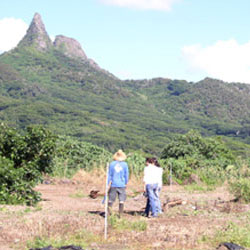Conservation Planning
Benefits of Conservation Planning
 The site visit is one of the first and most important parts of conservation planning. The site visit is one of the first and most important parts of conservation planning. |
|
Are you interested in starting a conservation plan?
Any agricultural producer in Hawai‘i – from nursery operators to ranchers to farmers large and small – is eligible to apply for a conservation plan through the SWCDs. Here’s how:
- Request an application packet and attend a District meeting. Application materials and meeting information for each district can be found at the SWCD office. Contact the nearest SWCD office to your property for assistance.
- Complete the application packet and send it back to the SWCD office. This information will help the planner better design your conservation plan.
- Set up a site visit. At the appropriate time, an SWCD Conservation Planner and/or District Director will contact you to set up a site visit. This visit is an opportunity for you to discuss your concerns, the objectives of your operation and practices you want to include in your plan.
- Decide which practices are applicable to your operation. During the review process, you can adjust the conservation plan to meet the present and future needs of your operation.
- Sign your conservation plan. You will be invited back to another District meeting to have your conservation plan signed by you and the SWCD Directors.
Your completed conservation plan will serve as a written record of your management decisions and the conservation practices you plan to implement in your operation. The plan itself will include tools like aerial photographs of your farm, crop and livestock data, a schedule for applying conservation practices, and instructions for establishing, maintaining and operating your conservation practices. You will also receive information about the soils on your farm and details about nearby streams, aquifers, ditches and other water resources. You may request to update your conservation plan at any time.